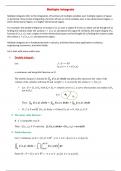Notes de cours
Intégarles_Multiples_et_Transformations_Intégrales_Licence_3_Mathématiques
- Établissement
- Paris VI - Université Pierre Et Marie Curie
Notes détaillées sur les intégrales multiples et transformations intégrales, les mots c'est en anglais simple mais la partie mathématiques est facile à comprendre.
[Montrer plus]



